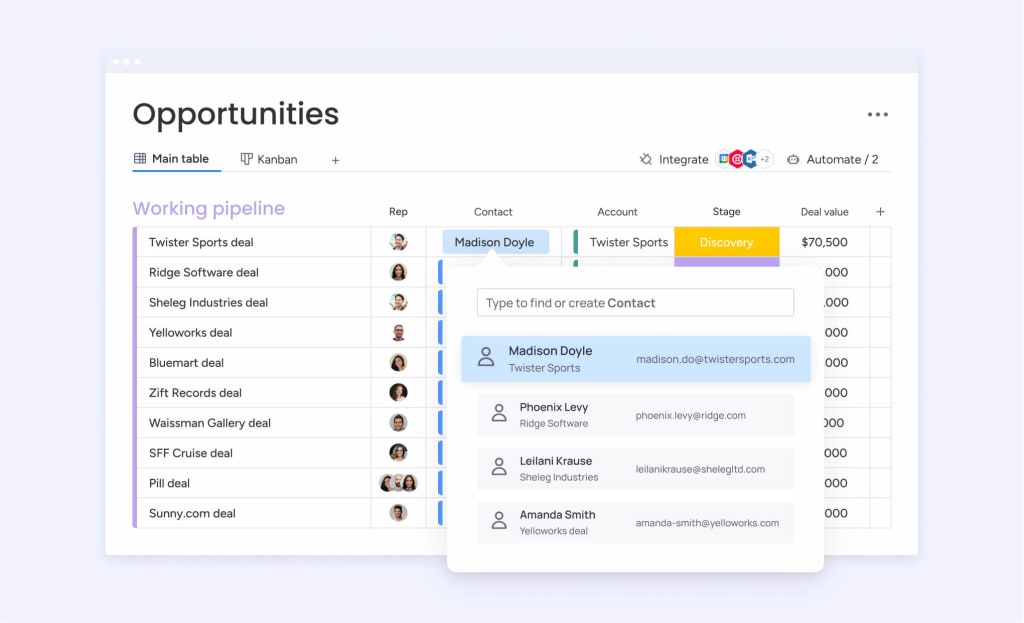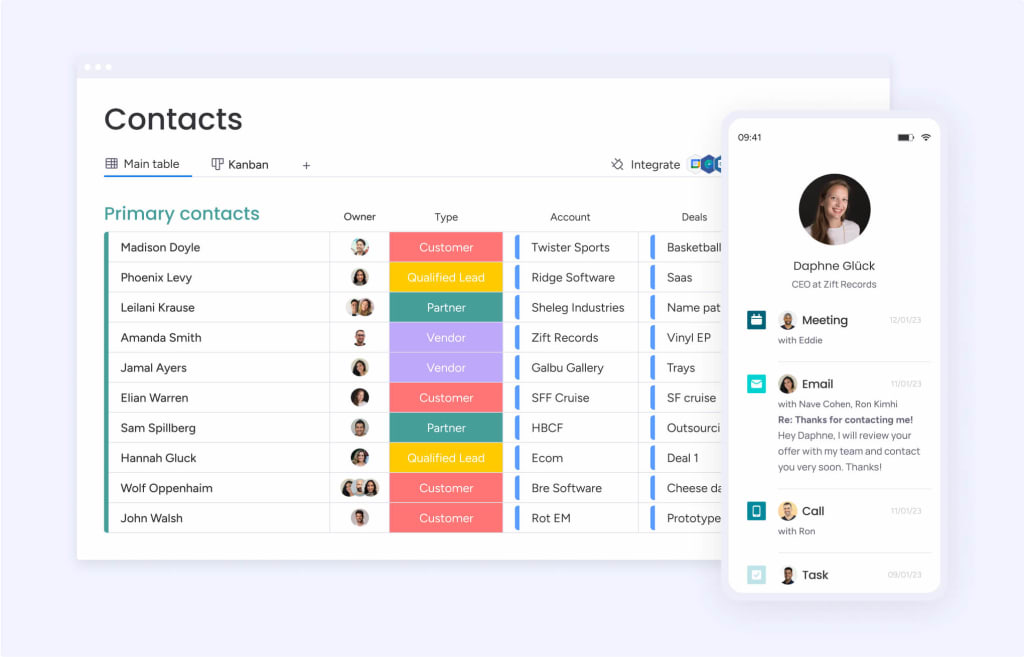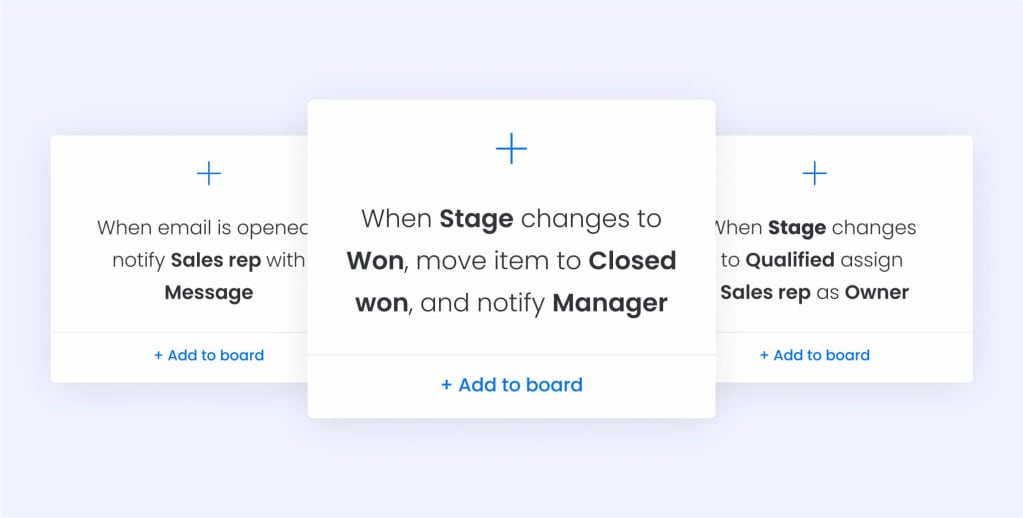When Christopher Columbus set out in 1492 to discover a westward route from Europe to Asia, he accidentally landed in the Americas. The problem? Bad data. Columbus had miscalculated the Earth’s size and underestimated the distance between Europe and Asia, leading him to find the Bahamas instead.
Just as inaccurate information threw Columbus’s journey off course, sales and customer experiences can similarly go astray without accurate, up-to-date information. Data forms the backbone of business decisions, and when the intel is lacking or incorrect, this leads to misguided strategies, ineffective outreach, and missed opportunities.
This guide introduces the topic of data enrichment as a way to enhance existing data with additional, relevant information. We’ll also explore how monday sales CRM integrates with Crunchbase to support your data enrichment practices, build better relationships and improve sales outcomes.
What is data enrichment?
Data enrichment, also known as data appending, is the process of upgrading your existing data sets to improve the quality and accuracy of the information. Your additional data might include:
- Demographic information: age, gender, income
- Geographic information: address, location data
- Firmographic information: company size, industry
- Behavioral information: purchase history, engagement metrics
Data enrichment can involve both manual and automated methods. Manual data enrichment includes conducting research to find missing or updated information on an individual or organization. In contrast, automation uses machine learning and AI algorithms to match existing data with external data sources to fill in any gaps.
Data enrichment example
Imagine your retail business wants to understand if your customer’s buying preferences vary according to the location of your urban and suburban stores. You might enrich your data with behavioral and geographic insights to pinpoint which products resonate with customers in each store’s vicinity.
By doing so, you notice that your suburban store attracts young families who tend to prefer your children’s clothing and toy products. In contrast, your urban store location has a higher concentration of young professionals with a stronger desire for upscale fashion and electronics.
Armed with this knowledge, your marketing teams can tailor relevant campaigns to local customer segments, ensuring they’re aware of the latest product launches, and sales information.
Data enrichment vs. data cleansing
Data enrichment and data cleansing are sometimes used interchangeably, but there are key differences between these terms:
- Data enrichment focuses on enhancing current data to make it more relevant and actionable.
- Data cleansing refers to checking over current data for errors and inconsistencies, then correcting or deleting the data.
4 benefits of data enrichment
Investing in the data enrichment process is a commitment, but it also has key benefits for your organization, including the following:
1. Storing high-quality data
Businesses can quickly get stuck in a cycle of storing all the data without paying attention to its quality.
Experian’s Global Data Management research reveals that 55% of business leaders lack trust in their data, preventing them from becoming fully data-driven. Similarly, 95% of organizations have experienced the impact of poor-quality data. However, companies can overcome these barriers to success by focusing on enrichment to elevate the value of the data they store.
2. Reducing data storage costs
Another advantage of focusing on quality over quantity is reducing data storage costs. Businesses are prone to wasting money by storing every single bit of data without understanding its value. For example, Veritas reports that 52% of organizational data is “dark,” meaning its content and value are unknown. Similarly, one-third of organizational data is defined as being ROT—redundant, obsolete, and trivial. But by constantly enriching your existing data sets, you’ll save money by only storing relevant, powerful data your business needs.
3. Creating personalized customer experiences
Enriched data enables sales and marketing teams to design targeted customer experiences.When you understand how your leads and customers are interacting with your brand and its products and services, this enables you to personalize all your customer communications and could even shape the development of new product features. This is essential for customer loyalty, with 62% of consumers confirming they would stray from a brand that doesn’t deliver a personalized experience.
4. Training AI
Companies already leaning on artificial intelligence to shape their decision-making and customer experiences, must prioritize data enrichment. When AI models are trained on the latest high-quality data, they make more accurate predictions, and have greater context and background information to understand the data they’re processing.
When should you invest in data enrichment?
Data enrichment isn’t a one-time event. For your information to remain current and meaningful, create an appending timetable that incorporates the following:
- Regular updates: You might follow a monthly, quarterly, biannual, or annual schedule according to the size and complexity of your data.
- Trigger events: You might choose to enrich your data after specific changes to your business, such as a product launch, entering a new market, or following an M&A.
- Performance analysis: You might conduct ad-hoc enrichment if you notice the quality of your data has declined. For example, if your customer mailing list has grown, but your engagement with marketing has reduced, this signals that your data quality might be compromised.
5 data enrichment best practices
Maximize your data enrichment approach by following the below best practices:
1. Define clear objectives
To measure if your data enrichment is effective, define SMART goals that are specific, measurable, achievable, realistic, and timely. This might include improving data quality by a certain percentage or increasing the accuracy of your customer segmentation.
2. Combine enrichment with data cleansing
There’s no point in enriching bad data, so cleaning your data first is critical. This step ensures you’re weeding out any errors, deleting irrelevant data, and then updating your remaining sets with relevant external information.
3. Select reliable data sources
Ensure that your third-party data is accurate, up-to-date, and relevant to your business or industry. For example, you might glean fresh insights from government databases, business information platforms like Crunchbase, LinkedIn profiles, or news articles.
4. Prioritize data security and privacy
As with any type of data handling, businesses must protect sensitive information and comply with relevant data regulations. Ensure that your data enrichment process is secure and transparent, and always gain customers’ consent to use their data.
5. Integrate data with your workflows
Data enrichment must be an ongoing process, deeply embedded into your existing workflows. This ensures your data remains up-to-date, and can be accessed easily by relevant teams for decision-making and customer engagement purposes.
Succeed at data enrichment with monday sales CRM
A CRM database goes hand-in-hand with data enrichment to ensure you offer an exceptional customer experience. Your CRM acts as a central repository which stores all the data you have on your leads, prospects, and customers. But this data must remain relevant if you want to keep in tune with their needs. Here are the features of monday sales CRM that will be integral to a successful data enrichment process:
- Data filtering: Keep your data organized and searchable using filters, enabling you to sort according to different properties like location, name, email address, and more.
- Dashboards: Pull crucial information into a centralized, customizable dashboard, enabling you to access your contact records quickly.

- Collaboration: Keep key marketing and sales team members in the loop with easy communication. View relevant emails, meeting notes, and other crucial conversations in one place, and log your data enrichment activities accordingly.

- Automation: Set up no-code automation sequences to review, move, and delete data as part of your data enrichment or cleansing practices. For example, to remind a sales manager to conduct a data enrichment review, you might create a trigger event that sends an email alert or Slack notification after six months has expired.

- Integrations: Link monday sales CRM to third-party business intelligence platforms like Clearbit to pull in relevant data and enrich every record in your database.
monday sales CRM also integrates with Crunchbase, enabling users to pull relevant information about potential clients directly into their database. Instead of manually crawling Crunchbase, our integration saves sales and business development reps time by providing accurate data to prepare for prospecting calls and customize campaigns.

Enrich your data in monday sales CRM
Poor data quality can prevent your sales and marketing teams from engaging effectively with customers. That’s why data enrichment is a business imperative, enabling you to stay competitive and convert leads into customers. With monday sales CRM, you can easily integrate data enrichment into your existing workflows and ensure that your data remains accurate, and relevant at all times.
With monday sales CRM’s partnership with Crunchbase, you can easily integrate data enrichment into your existing workflows and ensure that your data remains accurate, and relevant at all times.
Don’t let poor data quality hold your business back. Prioritize data enrichment with monday sales CRM today.
FAQs
What is a data enrichment agent?
A data enrichment agent is a software program or tool that helps businesses collect and incorporate external data into their existing databases. These agents can update, and maintain the quality of your data sets over time.
How do you enrich lead data?
Companies can use a lead enrichment tool or software that integrates with a CRM database. This allows you to gather relevant information from various sources about your leads, such as their social media profiles, job titles, and company information. From here, you can add the data to your CRM database and keep it updated over time.
What is enriched data?
Enriched data is existing information that has already been upgraded with external data sources. This provides context, relevance, and accuracy to your data sets, allowing for more effective decision-making and customer engagement.

